Worried about climate change? No need to get political, or overly concerned. Just climb into the protective bubble of a Land Rover and isolate yourself from the world. You'll be safe, even as the winds of a changing climate swirl around you and buffet your fellow citizens.
That's the basic message of the latest Land Rover ad. In case you missed it, here's the gist: Severe weather is coming and everyone's getting worried. TV meteorologists issue warnings, worried parents grab supplies off the shelves. Amidst all this anxiety, one woman goes about her day, unconcerned by the rough winds and coming downpour. Why? She's got a Land Rover.
The commercial preys on the public's growing awareness about climate change. Indeed, a recent Stanford University poll found that 82 percent of Americans believe climate change is already occurring and they want government to take steps to address it. Of course, the Land Rover ad says nothing about the fact that gas-guzzling SUVs boost demand for fossil fuel, damage the environment and cause road-related injuries -- while doing nothing to encourage the healthy physical activity we all need.
President Obama announced recently that over the next decade he intends to put $2 billion in revenue from federal oil and gas royalties to pay for research on vehicles powered by alternative, non-fossil fuels. While that's a reasonable policy, if we really want to make the planet and its people healthier, we need more than new technology. We must also invest in efforts that get people out of their cars and support walking, biking and public transit -- activities that reduce our environmental impact and rates of diabetes and other chronic diseases.
Nearly half of all Americans don't get at least 30 minutes of physical activity each day (the amount recommended by the Surgeon General), but those who regularly take public transportation do -- simply by walking to and from transit locations. And, with increased activity comes lowered health care costs. Researchers at the University of Wisconsin, Madison found that if the inhabitants of 11 urban and suburban communities in Illinois, Indiana, Michigan, Minnesota and Wisconsin switched to bikes for 50 percent of all short trips between April and October, the states would save a combined $3.8 billion by preventing deaths and reducing health care costs. That same study found that if driving was replaced by biking, walking and public transit for all short trips in the same time period, the overall net health benefit from improved air quality would be $4.9 billion per year.
Safe pedestrian infrastructure also helps prevent injuries. After new traffic lights, pedestrian signals and speed bumps were installed near New York City schools, kids' injuries dropped by one third. Other research suggests that improving streets to better accommodate cyclists could make streets safer for everyone and reduce injuries overall.
Investing in walkable, bike-able streets also boosts local economies. In New York City, businesses on Eight and Ninth Avenues noted a 50 percent increase in sales receipts after the installation of protected bike lanes on the corridor. In Portland, Ore. -- famous for its biking culture -- a 2008 study found that bike-related industry contributes significantly to the local economy, providing 850 to 1150 jobs and generating about $90 million a year. In Iowa, the use of bikes saves $70 million in health care costs and generates $1 million each day for the state, according to an economic impact study released last year.
Sadly, there is a kernel of truth in Land Rover's recent campaign: Fear has long motivated people to lock themselves in their cars and drive. Violence and fear of violence impede physical activity and increase the use of cars. When people feel unsafe in their neighborhoods, they are less likely to walk or bike. This especially impacts people most vulnerable to violence in the first place, like children, women, people with disabilities and older adults. Fear of violence increases car use by those who can afford it, boosting the number of cars on the road, along with carbon dioxide emissions and unintentional injuries. Instead, we need to promote active transportation and invest in strategies that prevent violence before it occurs. The best "land rovers" humans possess are connected to our hips. The best way to stay healthy -- and keep our planet healthy -- is to use our legs. That means we need streets that support our ability to walk and ride bikes safely -- not bigger, fiercer cars.
We now have an opportunity to promote walking: The Centers for Disease Control and Prevention is seeking public comments to frame an anticipated National Call to Action by the Surgeon General aimed at identifying "opportunities and actions that can be taken... to increase walking and walkability throughout the nation by providing access to safe, attractive and convenient places to walk." Submit comments (here) by April 30, 2013.
There is a potent and dangerous illusion in Land Rover's ad: that we can deal with all threats by driving away from them. It won't work when we have wrecked our planet or ruined our health. We need safe, resilient people, buildings and communities -- that's the only strategy that will keep us truly safe.